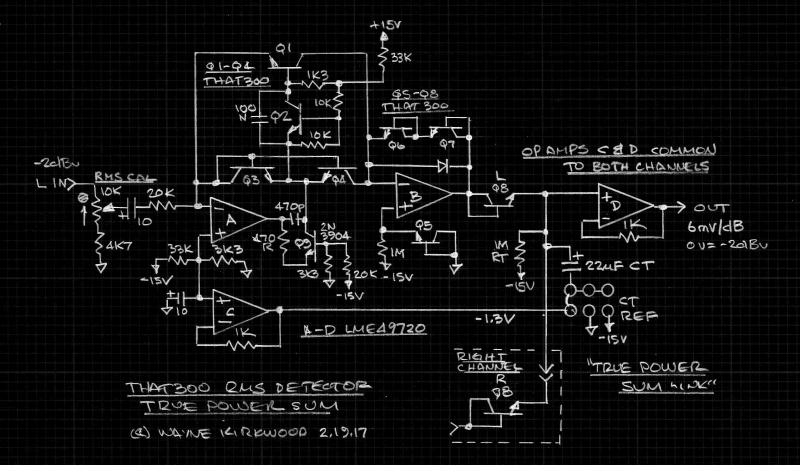Gary liked JR's common base stage, Q9.

THAT2252 replacement using THAT300 and current rectification with class A-B bias optimized for True Power Summing.
Current rectification is performed by op amp A, Q1-Q4 and Q9. (See also: viewtopic.php?f=6&t=856&start=16)
Q3 rectifies positive inputs. Q4 mirrors the current in diode-connected Q3.
Q2 provides class A-B bias for transistor Q1.
Q1 rectifies negative inputs.
Q1's collector current is a nearly-identical copy of the negative input current.
The collectors of Q1 and Q4 are combined to provide an output current equal to the absolute value of the input current.
The absolute value current output feeds the log converter at the inverting input of op amp B.
This particular log stage level-shifts the input to the converter, using Q5, so that the emitter of Q8 sets around 0V.
The THAT4305, 4315 and 4320 RMS detectors have a similar level shift.
This reduces temperature sensitivity when the detector output is combined with another channel for True Power Summing.
Since the timing capacitor (Ct) can now see either polarity I added op amp C to bias the -Ct terminal to below ground.
For polar electrolytic capacitors the -300 mV may not be significant and Ct- could be grounded.
Film timing caps could also be grounded.
Tantalum capacitors, which have tighter tolerance and lower DA excel as a Ct.
Tantalums prefer that the Ct- terminal be either biased negative by op amp C or tied to the -15V rail to avoid any reverse-polarity.
(A non-polarized Ct could also be made from two back-to-back capacitors. In the case of tantalums this is more expensive than op amp C.)
If Ct- is tied to the negative supply it is subject to supply noise and should also be rated at >16V.
The return current through Ct- is quite large and limited by op amp B's output current.
When Ct is grounded the return trace should be large.
Q8's dynamic impedance isolates op amp B's output from the large capacitive load of Ct.
When Ct- is referenced to op amp C's output it is also isolated from Ct's capacitive load by Q8.
When Ct- is connected to the -1.3V reference Ct's charging current is isolated from ground and returns to the supply rails.
Another advantage is that low-voltage tantalums can be used.
In this configuration a stereo True Power Sum detector uses 4 THAT300, and 3 LME49720 vs. 3 THAT300 and 3 LME49720 in the previous example.
